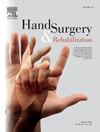改良戴尔技术矫正掌指关节非外伤性伸肌腱脱位及尺侧移位。
IF 0.9
4区 医学
Q4 ORTHOPEDICS
引用次数: 0
摘要
背景:掌指关节的慢性尺伸肌腱脱位会导致永久性的伸展缺损和尺漂移。一些软组织手术已经被描述为创伤后可复位不稳定的伸肌腱的重新调整,或者在炎症条件下掌指关节改变的情况下联合关节置换术。然而,没有研究报道孤立手术治疗掌指关节尺伸肌腱脱位后矫正伸展滞后和尺偏。本研究评估了采用改良的戴尔技术在掌指关节水平孤立矫正慢性非创伤性尺伸肌腱脱位的临床和功能结果。假设:本研究假设改良的戴尔技术允许伸肌器械重新对准,并矫正掌指骨伸展滞后和尺侧漂移。患者与方法:对2012年6月至2019年5月手术的10例患者(24指)进行评估,平均随访36个月。病因为类风湿关节炎17例,系统性红斑狼疮所致雅库德关节病4例,退行性关节炎3例。桡骨远端伸肌腱条,从表面向下绕过掌指关节桡侧副韧带,采用粉塔夫脱技术将其近端缝合到剩余的伸肌腱上。结果:伸展缺损明显改善,术后平均为- 26°(-9°),而术前为-35°。结论:改良的戴尔技术在治疗长指掌指关节水平慢性非外伤性尺伸肌腱脱位方面显示出良好的效果,可以调整伸肌系统,纠正掌指关节伸展滞后和尺侧漂移。证据等级:4级,单中心回顾性观察性研究。本文章由计算机程序翻译,如有差异,请以英文原文为准。
Correction of non-traumatic extensor tendon dislocation and ulnar drift at the metacarpophalangeal joint by the modified Dell technique
Background
Chronic ulnar extensor tendon dislocation at the metacarpophalangeal joint causes permanent extension deficit and ulnar drift. Several soft tissue procedures have been described for realignment of the extensor tendon in post-traumatic reducible instability or in combination with joint replacement in case of altered metacarpophalangeal joint in inflammatory conditions. However, no studies reported correction of both extension lag and ulnar deviation following isolated surgical treatment of ulnar extensor tendon dislocation at the metacarpophalangeal joint. The present study evaluated the clinical and functional results of isolated correction of chronic non-traumatic ulnar extensor tendon dislocation at metacarpophalangeal level using the modified Dell technique.
Hypothesis
The study hypothesis was that the modified Dell technique allows realignment of the extensor apparatus and correction of both metacarpophalangeal extension lag and ulnar drift.
Patients and methods
10 patients (24 fingers), operated on between June 2012 and May 2019, were evaluated at a mean follow-up of 36 months. The etiologies were rheumatoid arthritis in 17 cases, Jaccoud arthropathy due to systemic lupus erythematosus in 4, and degenerative in 3. A radial strip of distal-based extensor tendon, passed around the radial collateral ligament of the metacarpophalangeal joint downward from the surface, was sutured proximally to the remaining extensor tendon using the Pulvertaft technique.
Results
Extension deficit improved significantly, by a mean 26° (−9° postoperatively vs −35° preoperatively, p < 0.001). MP joint ulnar drift also improved significantly, by a mean 15° (6° vs 21°, p < 0.001). Four fingers had preoperative swan neck deformity that improved postoperatively. There were 2 cases of recurrent dislocation.
Conclusion
The modified Dell technique showed favorable results in treating chronic non-traumatic ulnar extensor tendon dislocation at metacarpophalangeal level in the long fingers, with realignment of the extensor system and correction of both metacarpophalangeal extension lag and ulnar drift.
Level of evidence
Level 4, single-center retrospective observational study.
求助全文
通过发布文献求助,成功后即可免费获取论文全文。
去求助
来源期刊

Hand Surgery & Rehabilitation
Medicine-Surgery
CiteScore
1.70
自引率
27.30%
发文量
0
审稿时长
49 days
期刊介绍:
As the official publication of the French, Belgian and Swiss Societies for Surgery of the Hand, as well as of the French Society of Rehabilitation of the Hand & Upper Limb, ''Hand Surgery and Rehabilitation'' - formerly named "Chirurgie de la Main" - publishes original articles, literature reviews, technical notes, and clinical cases. It is indexed in the main international databases (including Medline). Initially a platform for French-speaking hand surgeons, the journal will now publish its articles in English to disseminate its author''s scientific findings more widely. The journal also includes a biannual supplement in French, the monograph of the French Society for Surgery of the Hand, where comprehensive reviews in the fields of hand, peripheral nerve and upper limb surgery are presented.
Organe officiel de la Société française de chirurgie de la main, de la Société française de Rééducation de la main (SFRM-GEMMSOR), de la Société suisse de chirurgie de la main et du Belgian Hand Group, indexée dans les grandes bases de données internationales (Medline, Embase, Pascal, Scopus), Hand Surgery and Rehabilitation - anciennement titrée Chirurgie de la main - publie des articles originaux, des revues de la littérature, des notes techniques, des cas clinique. Initialement plateforme d''expression francophone de la spécialité, la revue s''oriente désormais vers l''anglais pour devenir une référence scientifique et de formation de la spécialité en France et en Europe. Avec 6 publications en anglais par an, la revue comprend également un supplément biannuel, la monographie du GEM, où sont présentées en français, des mises au point complètes dans les domaines de la chirurgie de la main, des nerfs périphériques et du membre supérieur.
 求助内容:
求助内容: 应助结果提醒方式:
应助结果提醒方式:


